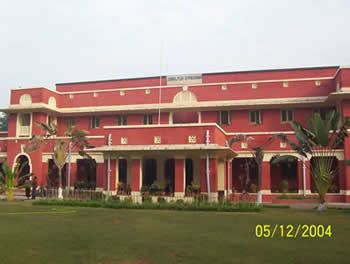 | ||
The Jamalpur Gymkhana (Hindi: जमालपुर जिमख़ाना), often referred to as Gymkhana (or merely Gym) by its members, is a hostel for young apprentice officers of the Indian Railways. It is also a club like any other Gymkhana. The difference is that membership to this club is restricted only to those who spend their formative years in its corridors. It is difficult to talk about Gymkhana without quickly moving on to the anecdotal history of its members - current and past, referred to as Gymmies by its inmates.
Contents
History
In the early 20th century, India faced a shortage of mechanical engineers in running a fast-growing rail system. The Indian Railways Institute of Mechanical and Electrical Engineering (IRIMEE), started in the year 1888 as Technical School. In the year 1927, the training of Mechanical Engineering Officers for Indian Railways commenced. It is the oldest of the six Centralised Training Institutes (CTIs) functioning for training of Officers of the Indian Railways. IRIMEE is located at Jamalpur in the Munger (spelled Monghyr, during the British rule of India) district of Bihar, on the Patna - Bhagalpur rail route.
IRIMEE conducts short term courses for Indian Railways Service of Mechanical Engineers (IRSME) Officers and other Organisations, 18 months training for IRSME Probationary Officers and four years undergraduate programme for the Special Class Apprentices (called SCAs or SCRAs for Special Class Railway Apprentices).
The 'Special Class Railway Apprentices' (SCRAs) stay at the Jamalpur Gymkhana during the four years when they undego training as undergraduate engineers. They have been doing so since 1929 when the Gymkhana was built.
Life after Graduation
Officers are assigned a Home Railway on completion of the course. This is the regional zone that will (usually) be where the officer will spend the first 4-8 (or more) years of the career.
The young officers go through an 18-month training and Bharat Darshan (Tour of India) to better understand, and designated as IRSME(P)/ ADME(P), with corresponding officers entering via IES exam:
On successful completion of this phase the officer is posted as an Astt. Div. Mech Engr (ADME). Depending on the posting, (s)he works directly under a SrDME or DME, or holds an independent charge. The officer may be posted to Zonal/Divisional HQs, Railway workshops, Diesel shed, Carriage/Wagon depots, or deputed to one of the Indian Railways companies. Having joined the service at a young age, the officers are likely to reach the top positions of the Railway Management.
Distinguished alumni
International Honours
National Honours
